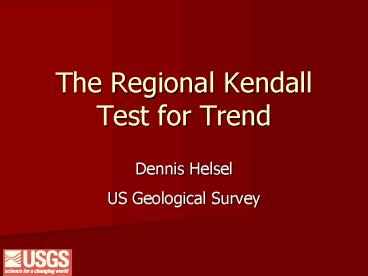The Regional Kendall Test for Trend - PowerPoint PPT Presentation
1 / 19
Title:
The Regional Kendall Test for Trend
Description:
Trends in snowpack chemistry during 1993-2004 in the Rocky Mountain region, USA ... Central Rocky Mountains ... vs. Central vs. Southern Rocky Mountains) ... – PowerPoint PPT presentation
Number of Views:46
Avg rating:3.0/5.0
Title: The Regional Kendall Test for Trend
1
The Regional Kendall Test for Trend
- Dennis Helsel
- US Geological Survey
2
Seasonal Kendall test for trend
- Most popular trend test in environmental studies
- Developed by Hirsch, Smith and Slack at the USGS
in the 1980s - Now used throughout the world
- Used for many media
- Software available from USGS since 1980s
3
Seasonal Kendall test for trend
- Nonparametric test
- Detects monotonic trends, not just linear
- Provides a measure of overall slope (rate of
change) - Conducts trend test within each season, then
combines to form one overall test
4
Regional Trends ?
- Spatial differences may be of more interest than
seasonal differences, especially for ground water
or other media without seasonal sampling - Would like an overall test of whether trends
occur across an entire region composed of
multiple sampling sites - A formal test in addition to visual up and down
arrows at multiple sites on a map
5
The Regional Kendall test
- Substitute location for season and run the
Seasonal Kendall test - Trend is tested at each location, then tests
combined to look for a consistent regional trend - Trends in different directions at different sites
will cancel each other out, leading to a
conclusion of no consistent regional trend
6
The Regional Kendall test
- Assumes similar amounts of data at each location
- Nonparametric
- Provides a slope estimate at each site, and one
overall for the region - Blatant knockoff of the Seasonal Kendall test!
7
Example
- Trends in snowpack chemistry during 1993-2004 in
the Rocky Mountain region, USA - George Ingersoll
- USGS
8
Field MethodsFull snowpack sample
- Sites selected free of local activity
- Temp physical characteristics measured
- Collected before annual melt begins
- Preserved frozen until analyzed for major ions,
pH, SC, DOC, mercury, isotopes Sulfur Nitrogen
9
Statistical methods
- Computed the Regional Kendall test in each of 3
sub-regions with different storm patterns and
airsheds - 54 sites in 3 sub-regions, 12 years
- NH4, NO3, SO4, snow depth
10
Sub-regions evaluated for long-term trends in NO3
No trend
MT
ID
WY
0.020 Kg/ha/yr
UT
.
Taos SV
0.032 Kg/ha/yr
CO
11
Nitrate in snow of theCentral Rocky Mountains
- 17 measurement locations
Site 16
- 3 of the 17 showed significant increases in NO3
concentrations
12
Nitrate in snow of theCentral Rocky Mountains
- 17 measurement locations
Site 20
- 3 of the 17 showed significant increases in NO3
concentrations
13
Nitrate in snow of theCentral Rocky Mountains
- 17 measurement locations
Site 53
- 3 of the 17 showed significant increases in NO3
concentrations
14
Nitrate in snow of theCentral Rocky Mountains
- 17 measurement locations
Site 28
- 14 of the 17 showed insignificant trends in NO3,
but most were still increases
15
Nitrate in snow of theCentral Rocky Mountains
- Significant trends and predominance of increases
(even when not significant) are combined and
evaluated by the Regional Kendall test
- Overall p-value is 0.004
Regional trend
16
How the Regional Kendall test works
- At each location, the test statistic
- S loc pluses - minuses
- for all comparisons between measurements
- Test statistic for regional trend
- SRK Sum S loc
17
How the Regional Kendall test works
- Scale SRK by dividing by its standard error.
The resulting ratio can be fit by a normal
distribution - Look up p-value
- Identical process to the Seasonal Kendall test
18
Adjunct methods to theRegional Kendall test
- Van Belle and Hughes (1984) proposed a test for
heterogenity of trend are the trends at
individual sites going in the same direction? - Can also use with collections of sites to test
for differences between sub-regional trends
(Northern vs. Central vs. Southern Rocky
Mountains)
19
Availability of Code
- USGS Scientific Investigations Report (SIR) 2005
- 5275 by Helsel, Mueller and Slack - .exe file runs using DOS commands within Windows
- Jim Slacks original code was refurbished to run
the Regional Kendall test, as well as simple
Kendalls tau correlation. - Report and software available online at
- http//pubs.er.usgs.gov/usgspubs/sir/sir20055275































